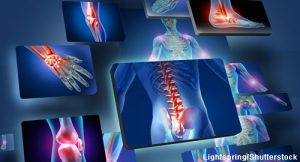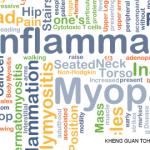 Our understanding of myositis phenotypes has greatly improved since the landmark publication of the Bohan and Peter criteria in 1975.1,2 However, treatments for various types of myositis have not advanced at the same rate. At the 2021 ACR State-of-the-Art Clinical Symposium, Hector Chenoy, PhD, FRCP, BMBS, MSc, BMedSci, professor of rheumatology and neuromuscular disease, Division of Musculoskeletal & Dermatological Sciences, University of Manchester, U.K., described the clinical trials on myositis conducted in recent years.
Our understanding of myositis phenotypes has greatly improved since the landmark publication of the Bohan and Peter criteria in 1975.1,2 However, treatments for various types of myositis have not advanced at the same rate. At the 2021 ACR State-of-the-Art Clinical Symposium, Hector Chenoy, PhD, FRCP, BMBS, MSc, BMedSci, professor of rheumatology and neuromuscular disease, Division of Musculoskeletal & Dermatological Sciences, University of Manchester, U.K., described the clinical trials on myositis conducted in recent years.
Dr. Chenoy began his presentation by noting that glucocorticoids remain the first-line treatment for idiopathic inflammatory myopathies, with intravenous pulse dose therapy recommended for life-threatening complications, such as myocarditis and rapidly progressive interstitial lung disease (ILD). Yet many patients suffer from refractory disease and comorbidities despite treatment with glucocorticoids or potent immunosuppressive medications. Thus, researchers have explored whether existing medications used to treat other rheumatic conditions may hold promise for patients with myositis.
Jakinibs
Janus kinase inhibitors (jakinibs) have traditionally been used to treat rheumatoid arthritis. Ladislau et al. noted that patients with dermatomyositis demonstrate an upregulation of type I interferon-inducible genes in muscle, endothelial tissue, skin and peripheral blood cells. In their proof-of-concept study, the researchers demonstrated several pathogenic effects of type I interferon, such as interruption of myotube formation in differentiating myoblasts. Ruxolitinib, which inhibits JAK1 and JAK2, was shown to stop these pathogenic effects in vitro. The four patients treated with ruxolitinib in the study experienced improvement in skin lesions, muscle weakness, serum type I interferon levels and interferon-inducible gene levels.3
With this in mind, Paik et al. conducted an open-label pilot study of tofacitinib, which inhibits JAK1/JAK2, JAK1/JAK3 and JAK2/JAK2, in patients with refractory myositis. The researchers administered tofacitinib in extended-release doses of 11 mg daily to 10 patients with dermatomyositis who had completed a washout of all steroid-sparing agents prior to initiating tofacitinib treatment.
The primary outcome measure was improvement in disease activity based on the International Myositis Assessment and Clinical Studies (IMACS) group definition of improvement.4 The IMACS score uses several core set measures, including physician global activity score, patient global activity score, manual muscle strength, physical function as measured by health assessment questionnaire, laboratory assessment of muscle enzymes and related laboratory parameters, global disease activity, physician global damage score, patient global damage score and health-related quality of life measures. The definition of improvement corresponded to improvement in three of any six core measures by >20%, with no more than two core set measures worsening by >25% (not including manual muscle testing). This outcome was achieved by all 10 patients.
As part of the primary endpoint, the response rate was determined according to the total improvement score using the 2016 ACR/European League Against Rheumatism (EULAR) myositis response criteria. Fifty percent of patients had minimal improvement and 50% of patients had moderate improvement in disease activity as measured by these criteria. The medication was well tolerated, with no significant adverse effects.
Paik et al. noted this study demonstrated clinical effcacy of a pan-jakinib using validated myositis response criteria and that randomized controlled trials are indicated to further explore this treatment.5
Researchers have demonstrated the clinical efficacy of a pan-jakinib using validated myositis response criteria. More randomized controlled trials are necessary to further explore this treatment option.
Reexamining Treatments
Dr. Chenoy pointed out that what’s old is new again. Although tacrolimus was already being studied in patients with refractory polymyositis and interstitial lung disease (ILD) in 1999, calcineurin inhibitors are once more a subject of interest, as demonstrated by a study comparing prednisolone and tacrolimus with prednisolone and cyclosporin A in the treatment of ILD in patients with dermatomyositis and polymyositis.6
This prospective, multicenter, open-label, randomized phase 2 trial had a primary endpoint of progression-free survival in the intention-to-treat population after 52 weeks of follow-up. Although the difference was not statistically significant, patients in the group treated with prednisolone and tacrolimus had a higher rate of progression-free survival than the group treated with prednisolone and cyclosporin A (87% vs. 71%, P=0.16). In addition, the patients in the group treated with prednisolone and tacrolimus had a higher rate of overall survival compared with the group treated with prednisolone and cyclosporin A (97% vs. 93%, P=0.50). The forced vital capacity (FVC) did significantly increase in both groups.7
In 1992, plasma exchange and leukopheresis were studied in the treatment of patients with polymyositis and dermatomyositis.8 These treatments are again relevant as part of a combined treatment regimen for patients with anti-melanoma differentiation-associated gene 5 (anti-MDA-5) antibody-positive dermatomyositis, which is frequently associated with a rapidly progressive form of ILD. Patients with new-onset disease were treated with high-dose glucocorticoids (i.e., 1 mg/kg/day of prednisolone), tacrolimus and intravenous cyclophosphamide. Plasmapheresis was used if a patient’s condition worsened after the initial treatment regimen. This group was compared with a historical control group that had received high-dose glucocorticoids and the step-up addition of immunosuppressants, if indicated.
The most significant finding: The combined immunosuppressive group showed significantly higher six-month survival when compared with the historical control group (89% vs. 33%), indicating that up-front combined therapy may benefit patients with anti-MDA-5-antibody-positive disease with aggressive features.9
After citing a 1993 study evaluating high-dose, intravenous immunoglobulin (IVIG) infusions to treat dermatomyositis,10 Dr. Chenoy summarized the ProDERM study, a prospective, double-blind, randomized, placebo-controlled phase 3 study evaluating the efficacy, safety and long-term tolerability of IVIG in patients with dermatomyositis. This study is important because IVIG has been used off-label to treat dermatomyositis, but to date has not been proven efficacious in a large, randomized controlled trial.
In the ProDERM study, adult patients with dermatomyositis on a stable dose of standard therapy (i.e., mycophenolate mofetil, methotrexate, glucocorticoids or hydroxychloroquine) were randomized 1:1 to receive either 2 g/kg of IVIG or placebo every four weeks for 16 weeks. Patients who showed clinical deterioration in this period were switched to the alternate treatment. At week 16, all patients on placebo and those without clinical deterioration on IVIG received 2 g/kg of IVIG every four weeks for 24 weeks. The primary efficacy endpoint was the proportion of responders in each group with at least minimal improvement in the total improvement score (a composite response criteria) without deterioration at two consecutive visits up to week 16.11 The primary endpoint was met in 79% of patients receiving IVIG and 44% of patients receiving placebo. In terms of safety, treatment-emergent adverse events were comparable in the IVIG and placebo groups.11 This study confirmed the efficacy, safety and tolerability of IVIG treatment in adult patients with dermatomyositis.
In Sum
As Dr. Chenoy clearly outlined, this is an exciting time in myositis research, and much will be learned in the coming years regarding how to best treat patients with these diseases.
Jason Liebowitz, MD, completed his fellowship in rheumatology at Johns Hopkins University, Baltimore, where he also earned his medical degree. He is currently in practice with Skylands Medical Group, N.J.
References
- Bohan A, Peter JB. Polymyositis and dermatomyositis (first of two parts). N Engl J Med. 1975 Feb 20;292(8):344–347.
- Bohan A, Peter JB. Polymyositis and dermatomyositis (second of two parts). N Engl J Med. 1975 Feb 20;292(8):403–407.
- Ladislau L, Suárez-Calvet X, Toquet S, et al. JAK inhibitor improves type I interferon induced damage: Proof of concept in dermatomyositis. Brain. 2018 Jun 1;141(6):1609–1621.
- Isenberg DA, Allen E, Farewell V, et al; International Myositis and Clinical Studies Group (IMACS). International consensus outcome measures for patients with idiopathic inflammatory myopathies. Development and initial validation of myositis activity and damage indices in patients with adult onset disease. Rheumatology (Oxford). 2004 Jan;43(1):49–54.
- Paik JJ, Casciola-Rosen L, Shin JY, et al. Study of tofacitinib in refractory dermatomyositis: An open-label pilot study of ten patients. Arthritis Rheumatol. 2020 Dec 1. Epub ahead of print.
- Oddis CV, Sciurba FC, Elmagd KA, et al. Tacrolimus in refractory polymyositis with interstitial lung disease. Lancet. 1999 May 22;353(9166):1762-1763.
- Fujisawa T, Hozumi H, Kamiya Y, et al. Prednisolone and tacrolimus versus prednisolone and cyclosporin A to treat polymyositis/dermatomyositis-associated ILD: A randomized, open-label trial. Respirology. 2021 Apr;26(4):370–377.
- Miller FW, Leitman SF, Cronin ME, et al. Controlled trial of plasma exchange and leukapheresis in polymyositis and dermatomyositis. N Engl J Med. 1992 May 21;326(21):1380–1384.
- Tsuji H, Nakashima R, Hosono Y, et al. Multicenter prospective study of the efficacy and safety of combined immunosuppressive therapy with high-dose glucocorticoid, tacrolimus and cyclophosphamide in interstitial lung diseases accompanied by anti-melanoma differentiation-associated gene 5-positive dermatomyositis. Arthritis Rheumatol. 2020 Mar;72(3):488–498.
- Dalakas MC, Illa I, Dambrosia JM, et al. A controlled trial of high-dose intravenous immune globulin infusions as treatment for dermatomyositis. N Engl J Med. 1993 Dec 30;329(27):1993–2000.
- Aggarwal R, Charles-Schoeman C, Schessl J, et al. Efficacy and safety of IVIG (octagam 10%) in patients with active dermatomyositis. Results of a randomized, double-blind, placebo-controlled phase III trial (ProDERM study) [abstract: 0955]. Arthritis Rheumatol. 2020 Oct; 72 (suppl 10).

